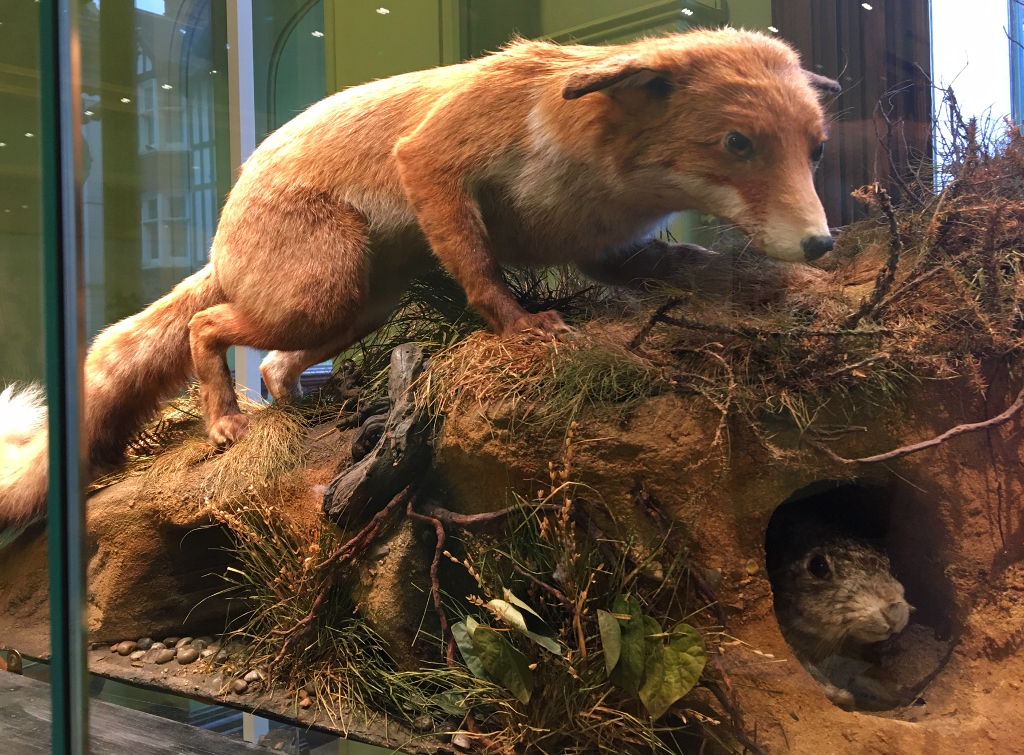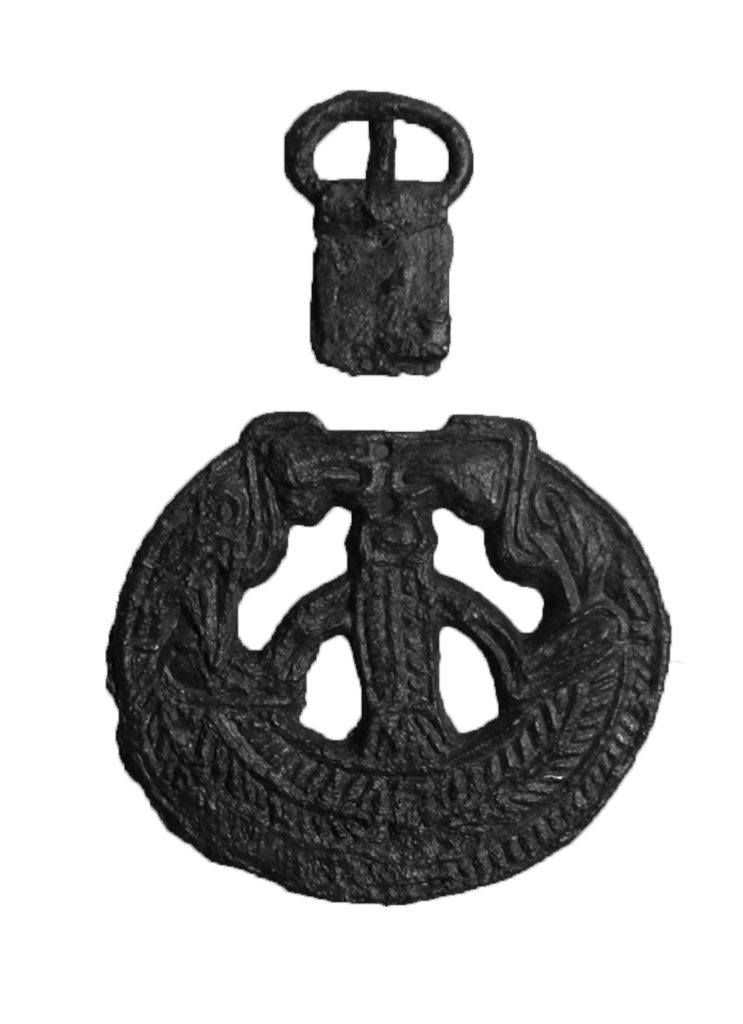
Anglo-Saxon mount and buckle C. 650 AD
Copper Alloy
This mount is decorated with two conjoined bird-headed creatures surrounding a fish motif in the centre. It is a great example of Anglo-Saxon design which often incorporated interweaving animal imagery, a style that points to the influence of the Vikings on local culture.
Upstairs, in the Explorers & Collectors gallery in the Anglo Saxon Kingdom of Kent case, you can see many more examples of these animal designs. Like this mount, many include birds which could well be ravens or crows, a reference to the chief god of the early Anglo-Saxons: Woden. Woden was associated with war and death, and he was believed to have two raven messengers.
Reference: 1978.3.1561
Can be found: The Garden Room Collection
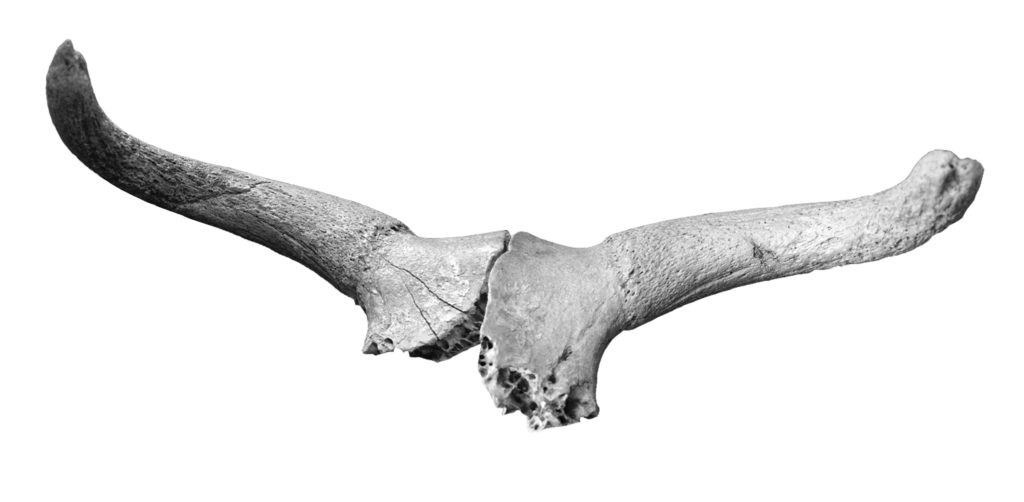
Aurochs skull fragments
Found in Milton Quarry, Cantebrury in 1988 Fossil (mammal)
The aurochs is the ancestor of the modern cattle depicted in the paintings of Thomas Sidney Cooper. The aurochs were larger and stronger than today’s cows, almost a foot taller and weighed around one tonne. The animal became extinct in 1627 when the last of the species died in Poland. These fragments of an aurochs’ skull were found at Milton Gravel Quarry in Kent.
The aurochs inspired some of the earliest artworks ever made, images of the animal can be found in prehistoric cave paintings such as those in Lascaux and Chauvet in France and Altamira in Spain. These depictions suggest that the animal had an important cultural and spiritual significance to our hunter-gatherer ancestors.
Reference: 1989.5
Can be found: The Garden Room Collection
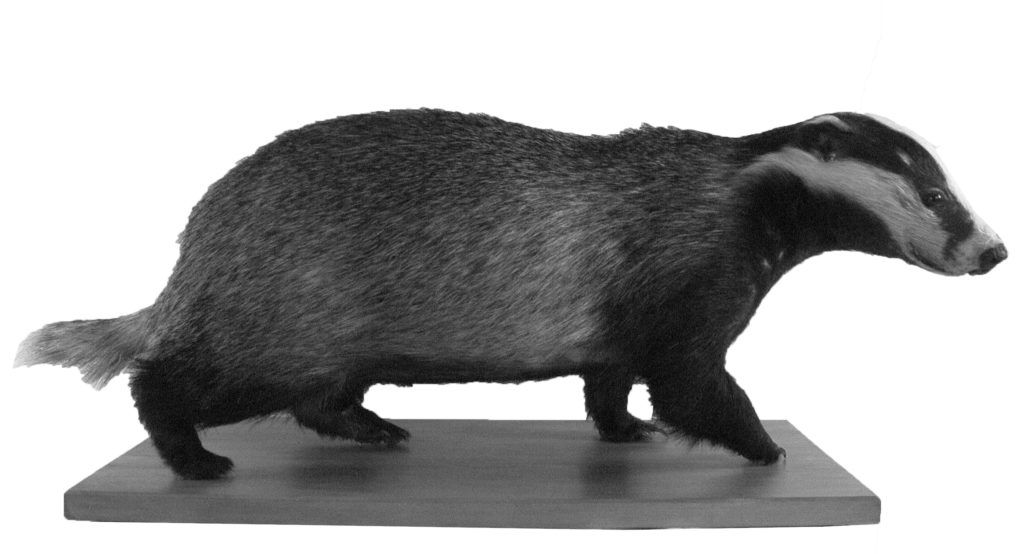
Badger
Taxidermy (mammal)
(This item has been temporarily removed from display for conservation work)
Badgers are the largest land predators living in the wild in Britain and they will eat almost anything. However, the main part of their diet is earthworms. Badgers are nocturnal and live in networks of underground burrows and tunnels called setts.
The badger’s characteristic black and white fur is instantly recognisable and has inspired a number of literary characters such as the best friend of Rupert Bear: Bill Badger.
Reference: 1992.47
Can be found: The Garden Room Collection
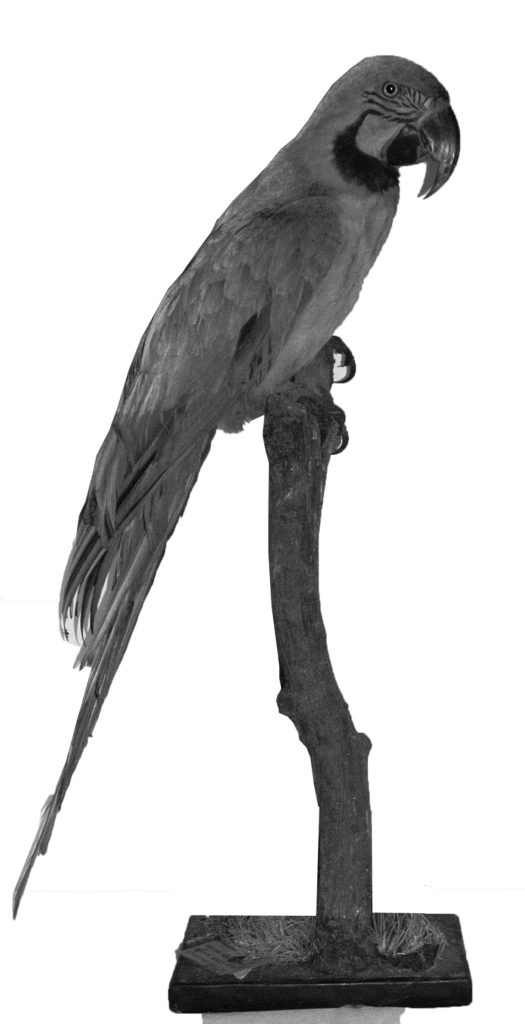
Blue and yellow macaw
Taxidermy (bird)
(This item has been temporarily removed from display for conservation work)
The colouring of macaws is an adaptation to life amongst the colourful fruits and flowers of the Central and South American rainforests. The birds have large, powerful beaks that they use to crack nuts and seeds. Macaws are very intelligent and social birds, they use their loud calls to communicate within their flock, to mark territory and to identify one another.
Some species can even mimic human speech which is one reason why macaws have been desirable as pets for centuries. This specimen was a much-loved pet for forty years and was given to the museum after it died by its owner who lived in Herne Bay.
Reference: 1999.83
Can be found: The Garden Room Collection
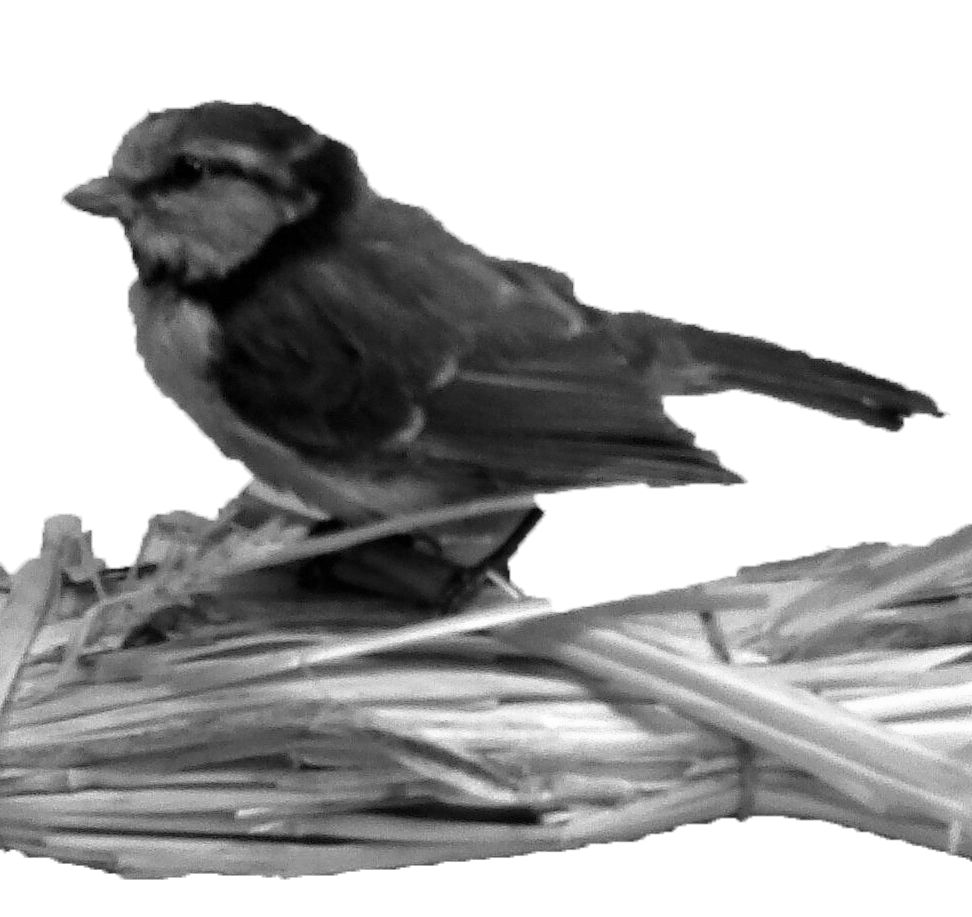
Blue tit
Taxidermy (bird)
Blue tits are very active birds, they hunt insects and spiders among the branches and leaves of trees in woodlands. They also eat seeds and nuts and when winter comes they form larger groups to search for food together.
Their recogniseable colouring of blue and yellow make blue tits one of Britain’s most popular garden visitors. They are well-adapted to gardens and towns and have even been observed breaking the tops of milk bottles to take the creamy top from the milk.
Bequeathed by William Oxenden Hammond, 1903,
Reference: 70 H
Can be found: The Garden Room Collection
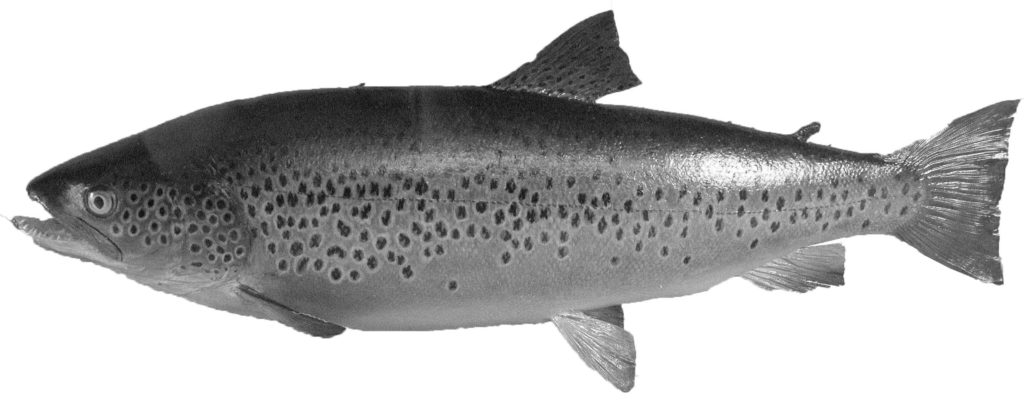
Brown trout
Taxidermy (fish)
The brown trout can be found throughout Britain in streams, rivers and lakes. These fish can see in almost every direction at once which helps them to be effective predators. Brown trout feed on insects, worms, larvae, crustaceans and small fish. Larger trout will sometimes even eat small swimming mammals, like voles and mice.
In Britain, people have been fishing for sport and leisure for hundreds of years and anglers have often been keen to preserve notable catches as trophies. This Brown Trout was caught by Mr Charles Bing in the River Stour on the 27th May 1926.
Reference: 1999.187.2
Can be found: The Garden Room Collection
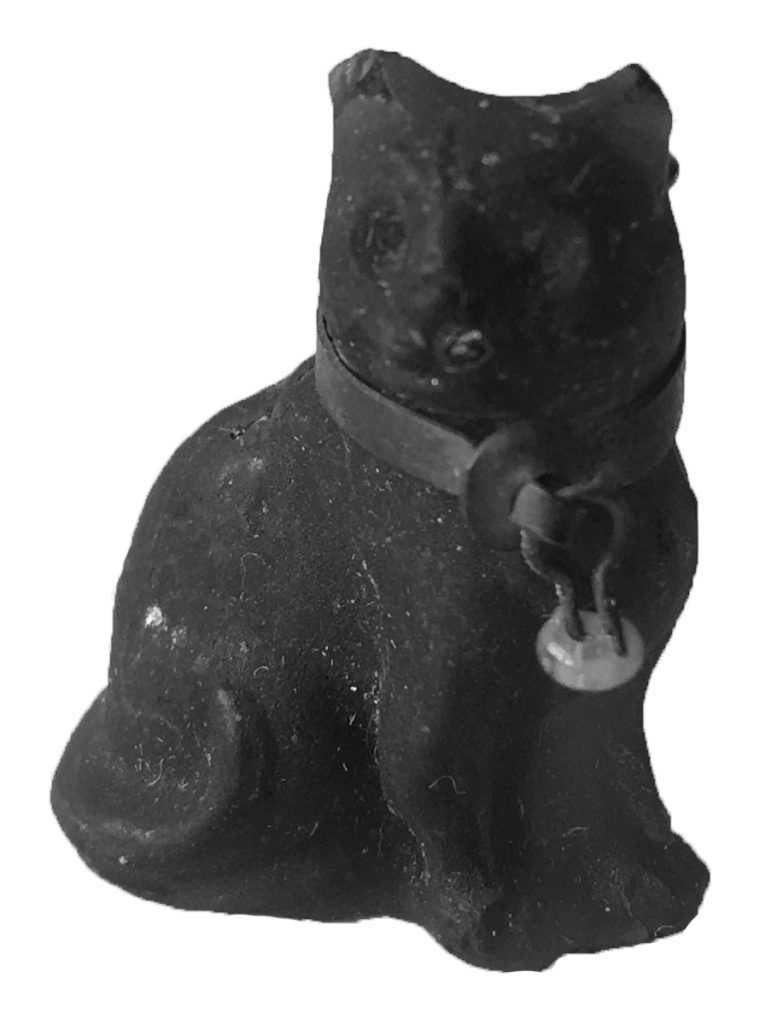
Cat charm
Early twentieth century
Glass
It’s likely that this charm was made in the Czech Republic (previously Czechoslovakia) in the late nineteenth or early twentieth century. It’s a tiny example of the long held affections many people have for cats. You can see examples of similar glass animal charms upstairs at The Beaney in the Materials and Masters gallery.
Charms like these were exported to the United States, France and to Britain. British companies often bought charms like this to put inside Christmas crackers which were invented by an English sweet maker named Tom Smith in the late 1840s and remain a popular novelty today.
Reference: CANCM:1992.38.16
Can be found: The Garden Room Collection
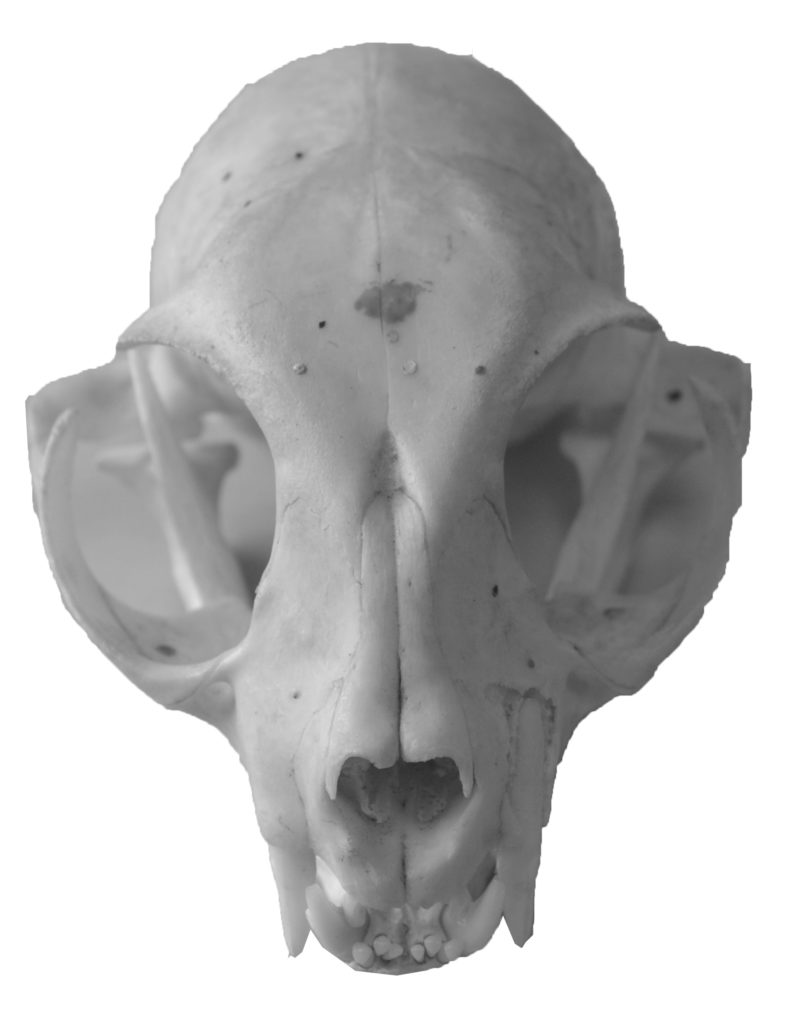
Cat skull and jawbone
Skeleton (mammal)
This is the skull of a domesticated cat. Like its larger relatives, such as lions and tigers, you can see it has long sharp teeth at the front of its mouth, this is an adaptation for hunting. Domestic cats are descended from wild cats and in the wild they would have eaten small mammals and birds.
It is believed that cats gradually became domesticated over the past eight thousand years. When people first grew crops and reared animals on farms it would have attracted rodents and it is likely that these rodents attracted wild cats. It’s probable that the domestication of such cats started as a form of convenient pest control.
Reference: CANCM:nn
Can be found: The Garden Room Collection

Chinese deer figurine
Made in China around the 19th Century
Bronze
Historically, in Chinese culture the deer is associated with longevity and prosperity. An ornament like this one may have been bought and displayed by someone hoping to bring about good fortune for their household.
In nineteenth century Britain there was a keen interest in Chinese art and design and many items were sold to British collectors. The deer as a motif was also very popular at the time, thanks in part to widely admired and reproduced animal paintings by artists such as Sir Edwin Landseer, a contemporary of Thomas Sidney Cooper.
Reference: 1996.70.18
Can be found: The Garden Room Collection
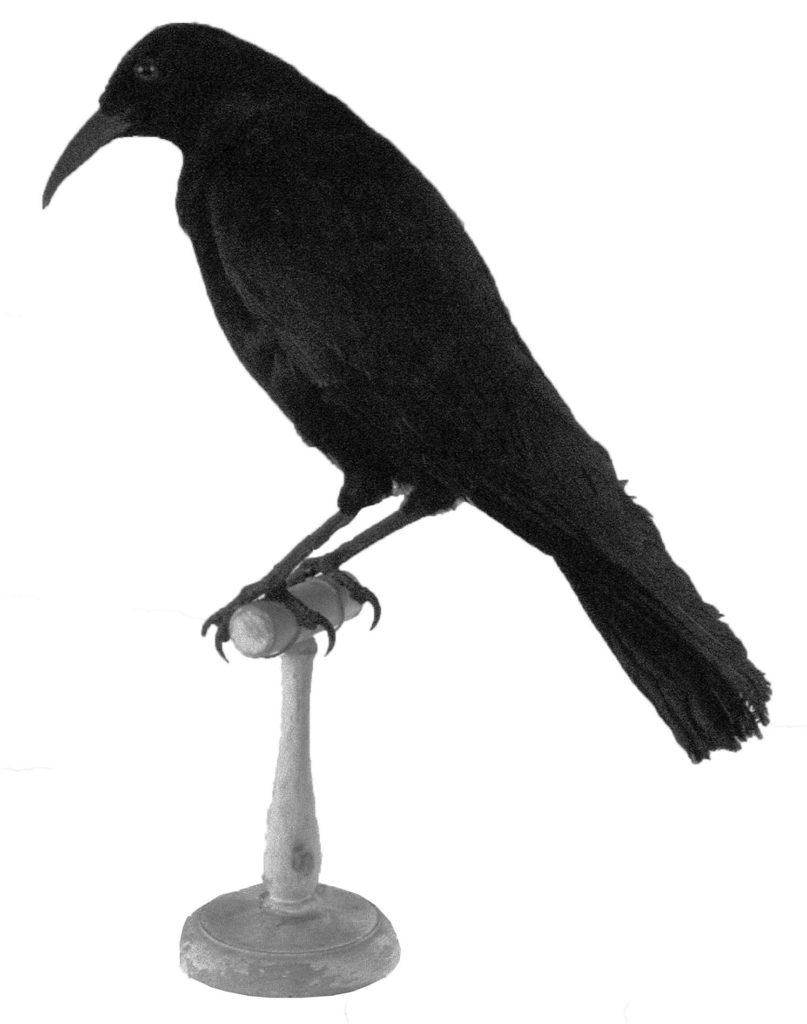
Chough
Taxidermy (bird)
Choughs (pronounced ‘chuffs’), along with crows, ravens, magpies and jays form a family of birds called corvids. Choughs eat insects and larvae and perform wonderful aerial displays of diving and swooping.
In the medieval period, choughs were known as ‘beckits’ after the unkind name given to people with prominent noses. There are three choughs on the Canterbury coat of arms, symbols taken from the family heraldry of Thomas Becket. You can find the city coat of arms around The Beaney including in the stained glass above the museum entrance, just outside The Garden Room.
Reference: 174H
Can be found: The Garden Room Collection
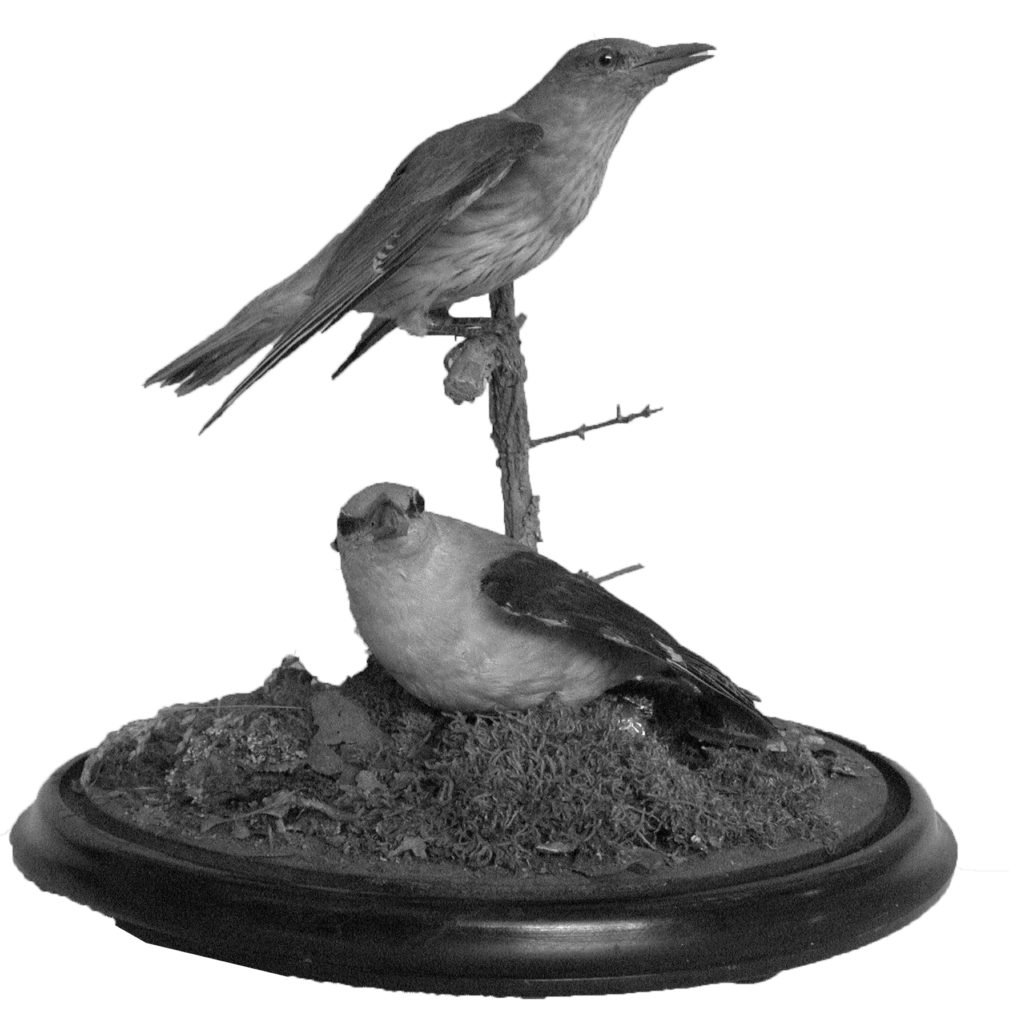
Golden oriole
Taxidermy (bird)
(This item has been temporarily removed from display for conservation work)
The golden oriole eats insects and berries, and likes to inhabit poplar plantations. The female birds are slightly different from the males, with spotted breast feathers.
The golden oriole is a rare visitor to Kent during the spring and summer months. During the nineteenth century when Thomas Sidney Cooper was working however, these birds were regular summer visitors.
Reference: 530H
Can be found: The Garden Room Collection
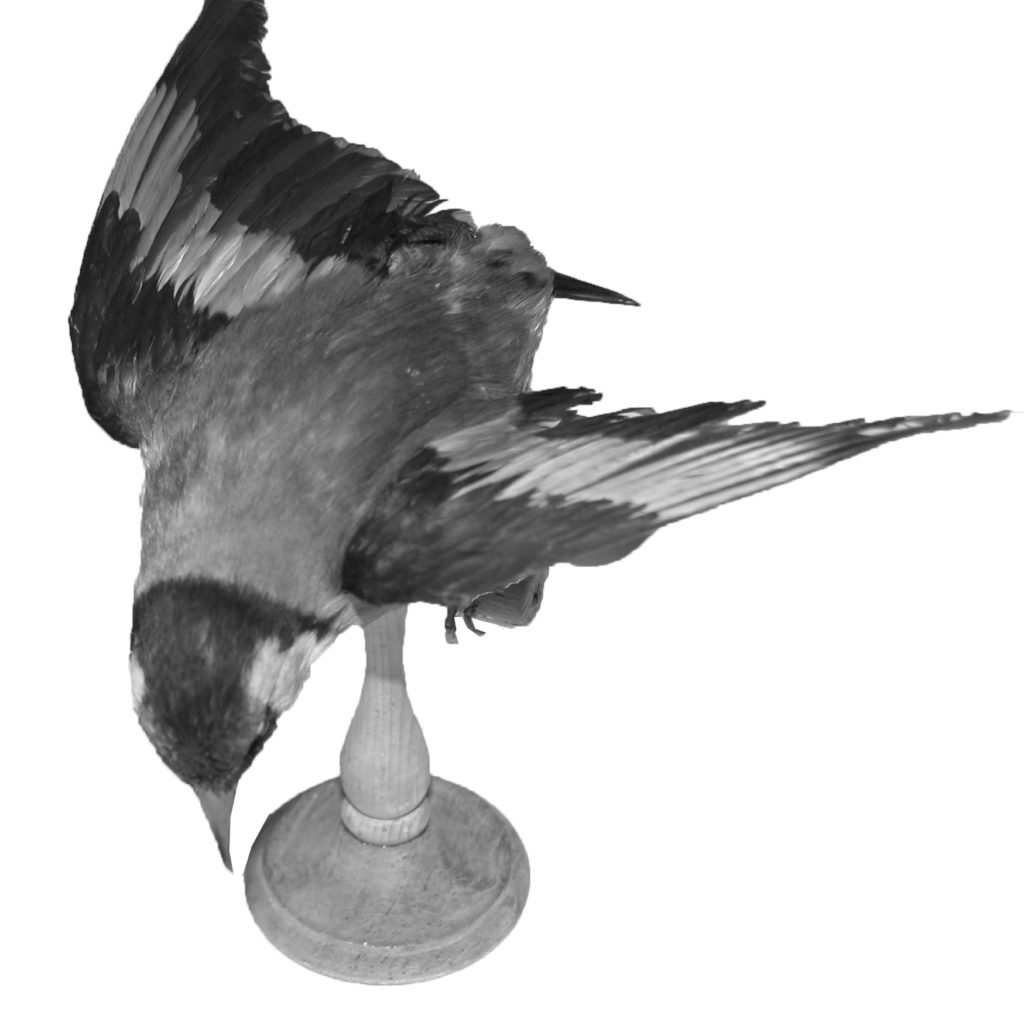
Goldfinch
Taxidermy (bird)
(This item has been temporarily removed from display for conservation work)
The goldfinch is recognisable by its bright red face and yellow wing patch. They can be seen in many places such as orchards, parks, gardens and heathland where they use their long, fine beaks to get to the seeds from thistles and dandelions.
The collective noun for a group of goldfinches is a ‘charm’, a group of owls is known as a ‘parliament’ whereas a group of crows is known as a ‘murder’. These terms all reveal something about the ideas, preferences and prejudices we have inherited in regards to different animal species.
Reference: CANCM:113 H
Can be found: The Garden Room Collection
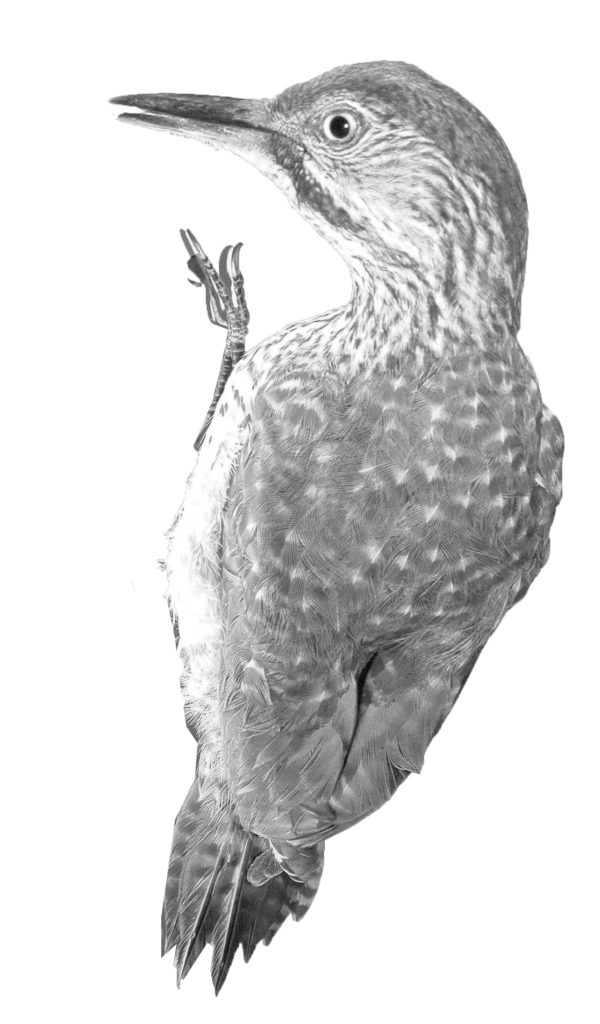
Green woodpecker
Taxidermy (bird)
The green woodpecker is the largest of the three woodpecker species in Britain. They have a short tail and a strong, long bill which they use to dig into ant colonies and consume huge amounts of ants.
Green woodpeckers have a very recognisable loud, laughing call which is why speakers of an old Kentish dialect called this bird a ‘yaffle’. This is where Peter Firmin and Oliver Postgate got the name for their woodpecker character: Professor Yaffle. You can see Professor Yaffle, Bagpuss and other Small Films characters on display upstairs at The Beaney.
Reference: (exKCC)
Can be found: The Garden Room Collection
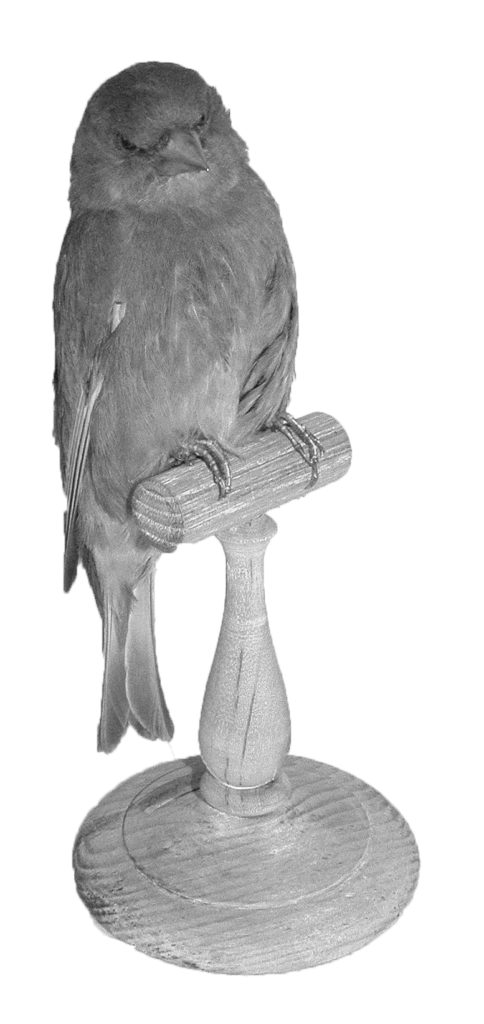
Greenfinch
Taxidermy (bird)
These finches like to nest in conifer trees and to eat black sunflower seeds. Greenfinches are a common garden visitor and are thought to be quite sociable birds. However they are sometimes observed squabbling with other birds at feeding tables. Visitors sometimes remark that this specimen looks quite grumpy.
Greenfinch populations declined during the late 1970s but increased dramatically during the 1990s. A recent decline in numbers has been linked to an outbreak of a parasite-induced disease which prevents the birds from feeding.
Reference: 115 H
Can be found: The Garden Room Collection
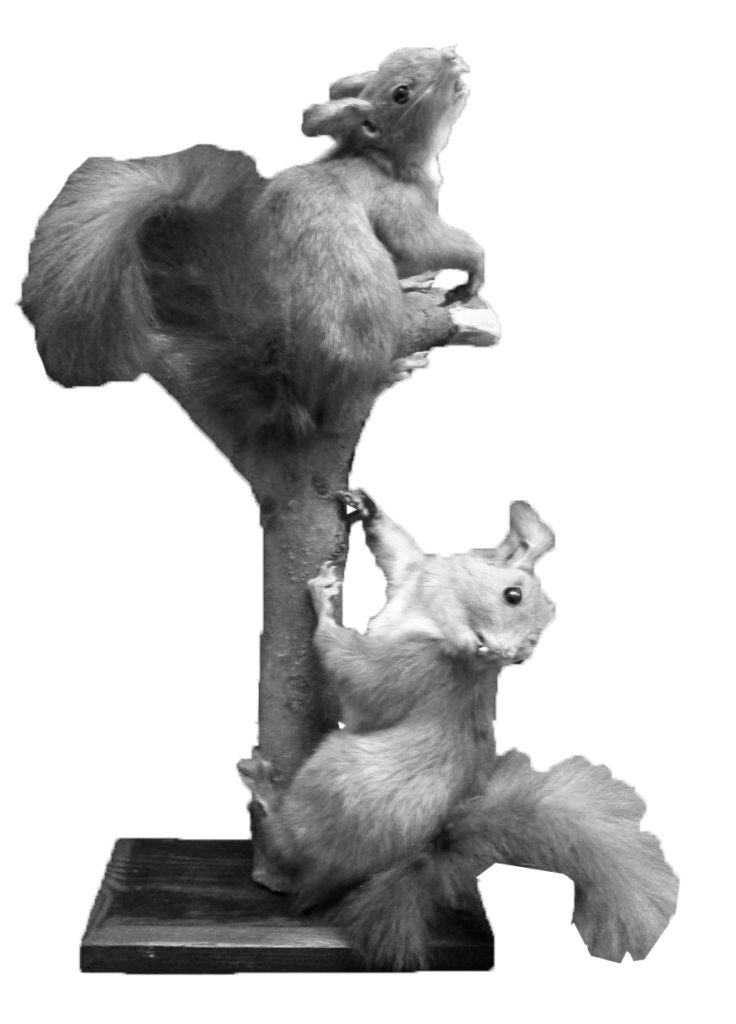
Grey and red squirrels
Taxidermy (mammal)
Squirrels are a common sight in British woodlands. There are two types that can be found in Britain: the grey, and the red squirrel. The red squirrel is smaller than the grey. It is found in Scotland, pockets of northern England and Wales, and small islands off England’s south coast. The grey is much more common, and can be seen throughout Britain.
Red squirrels have experienced the most drastic decline in numbers of all UK mammals, mostly due to the introductions of the grey squirrel in the 1900s. The greys carry a disease called ‘squirrelpox’, which they are immune to, but is deadly to the reds.
Reference: CANCM:1999.221.2 / CANCM:1990.68
Can be found: The Garden Room Collection
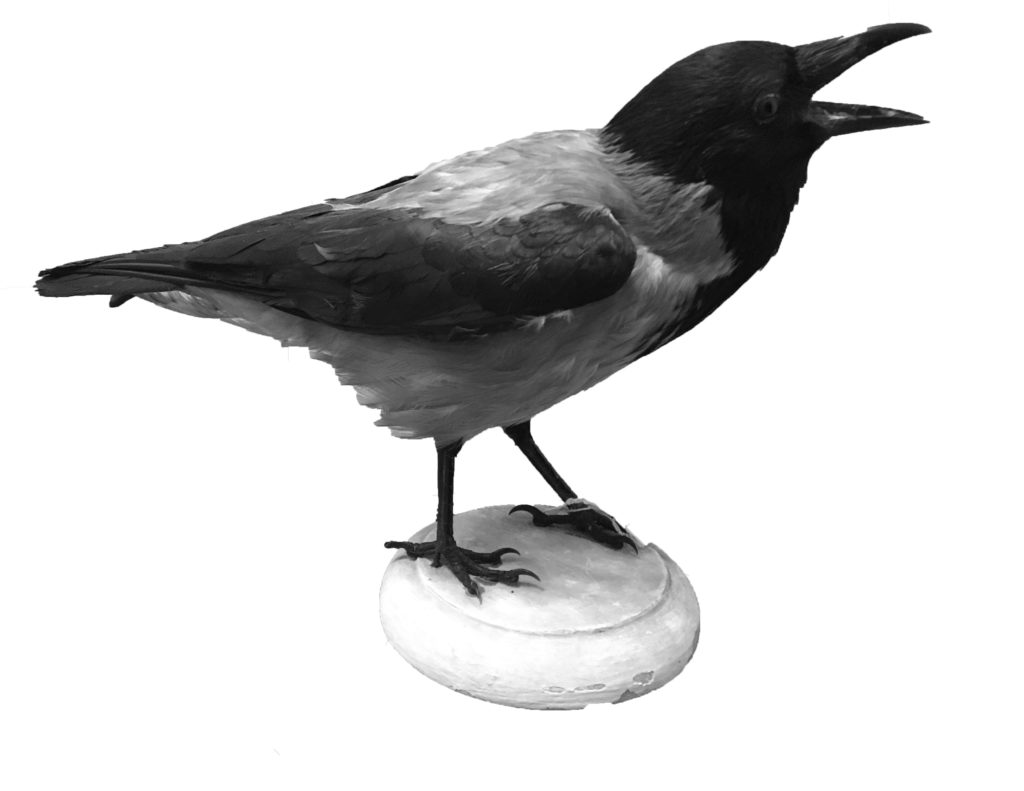
Hooded crow
Taxidermy (bird)
(This item has been temporarily removed from display for conservation work)
Hooded crows, like their more common relatives, are highly intelligent opportunists. Crows will eat almost anything including dead and decaying flesh. The sight of crows scavenging from dead bodies is one of the reasons why throughout history, people all over the world have associated these birds with death.
When making ‘Separated but not divorced’, which you can see on display in The Garden Room, Thomas Sidney Cooper originally included a crow pecking at bones in the bottom left corner of the painting. However he decided to remove the bird from the final composition, perhaps he thought it was too ominous a symbol.
Reference: CANCM:178 H
Can be found: The Garden Room Collection
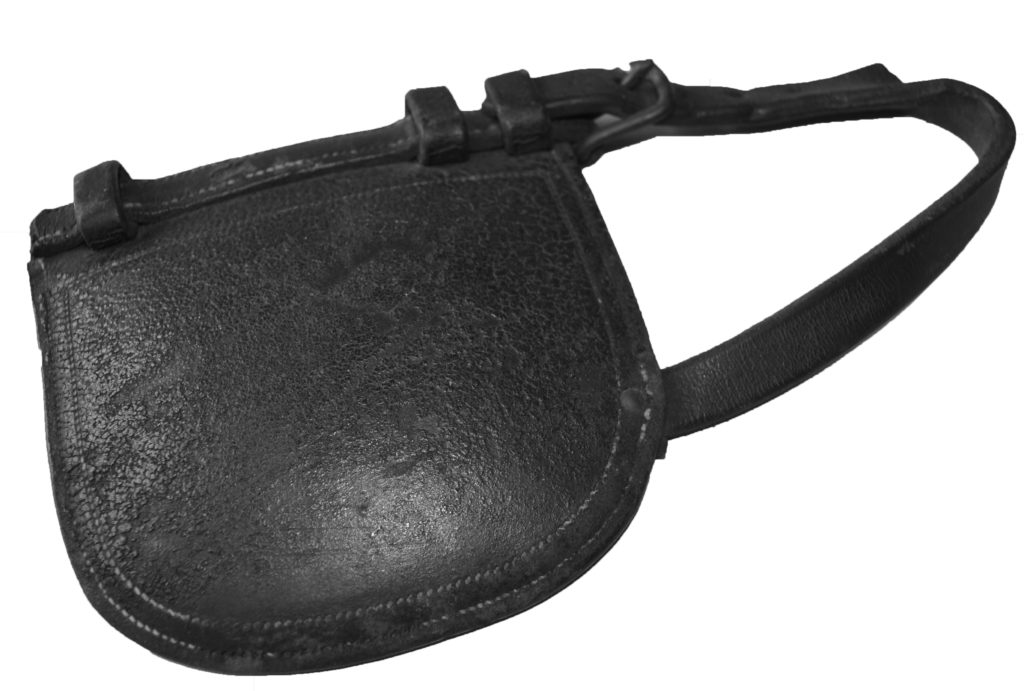
Horse blinkers
Early 20th century
Leather
Horse blinkers, sometimes known as blinders are part of the equipment used when horses are deployed as working animals. The blinkers prevent the horse from seeing behind them and in some cases to the side.
Blinkers have been most commonly used for horses that pull loads, the idea is that the blinkers keep the horse focused on what is in front of them and keeps them from becoming distracted or spooked, especially in crowded streets.
Reference: CANCM:nn
Can be found: The Garden Room Collection
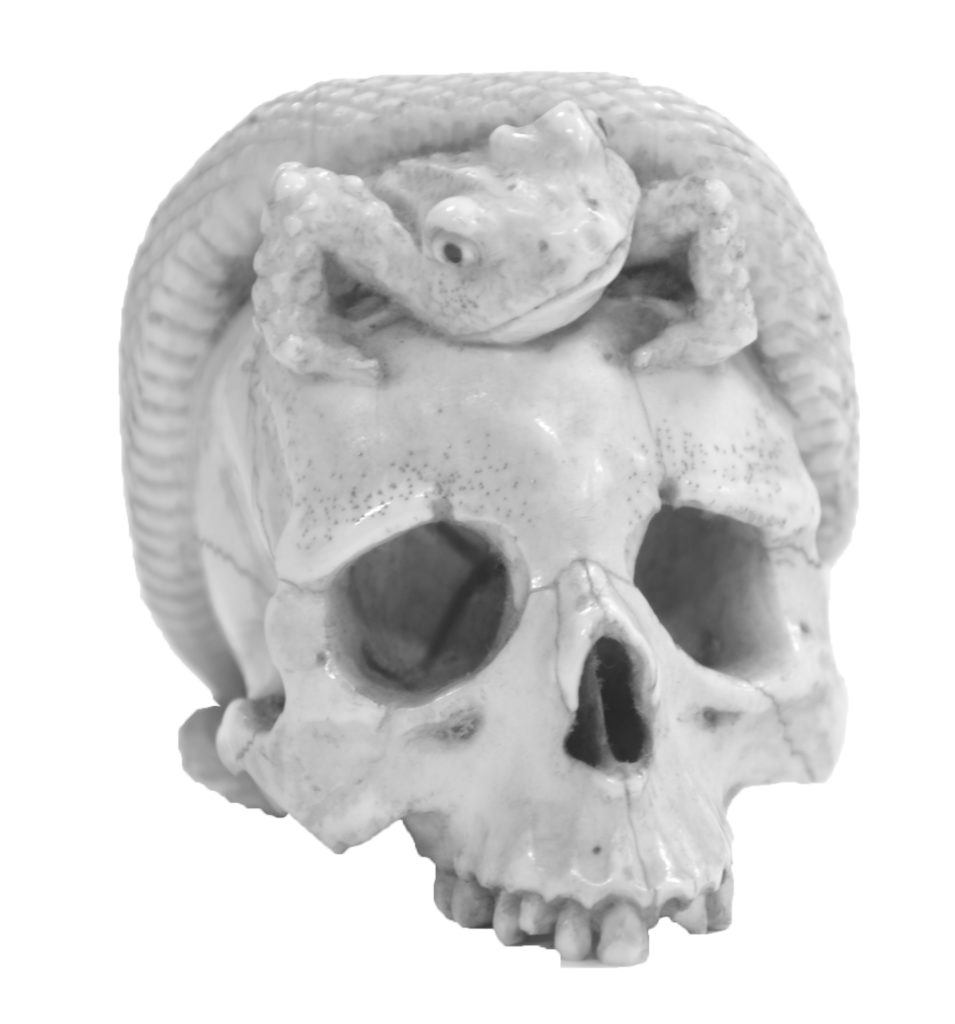
Japanese carving (skull, snakes, frogs)
Made in Japan, about ?
Ivory
This detailed sculpture could be a netsuke like the one on display nearby or it could be an okimono. A netsuke had a function as a toggle whereas an okimono was made solely for display. Skulls and snakes are common motifs in both kinds of sculpture, as are other animals, people, and gods.
The snake pursuing the frog on top of a human skull reflects Buddhist ideas on the impermanence of life. For its original owner this object may have been a humble reminder that like the frog, they too were subject to nature and to death. Objects like this one have much in common with the memento mori of Christian culture.
Reference: CANCM:7972
Can be found: The Garden Room Collection
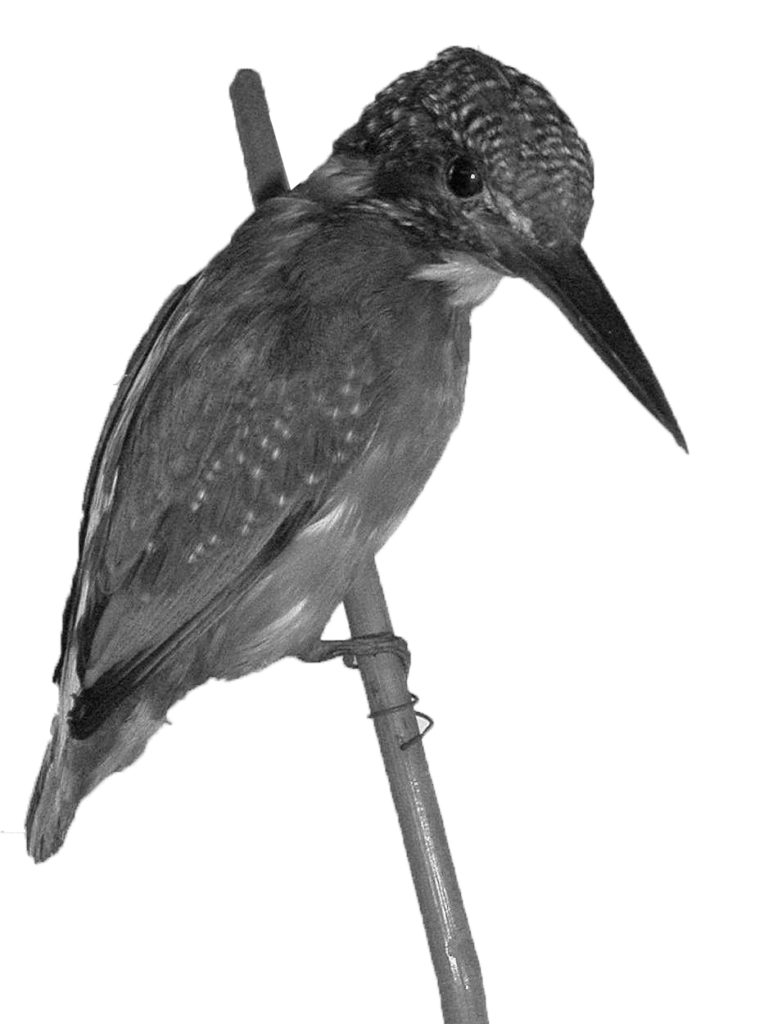
Kingfisher
Taxidermy (bird)
Kingfishers can be spotted around bodies of water, like streams and rivers. As their name suggests, they are excellent fishers, and will wait on low hanging branches, then quickly dive in to catch small fish. Mating kingfishers don’t use any materials to make their nests, instead they dig nest tunnels in vertical, sandy river banks.
They are so fast, most sightings of them are described as a ‘blue flash’. So it may surprise you to know the main portion of this bird is brown, not blue! This phenomenon is known as structural colouration. While the features themselves are brown, their structure reflects short waves of light, making you see blue.
Reference: 203 H
Can be found: The Garden Room Collection
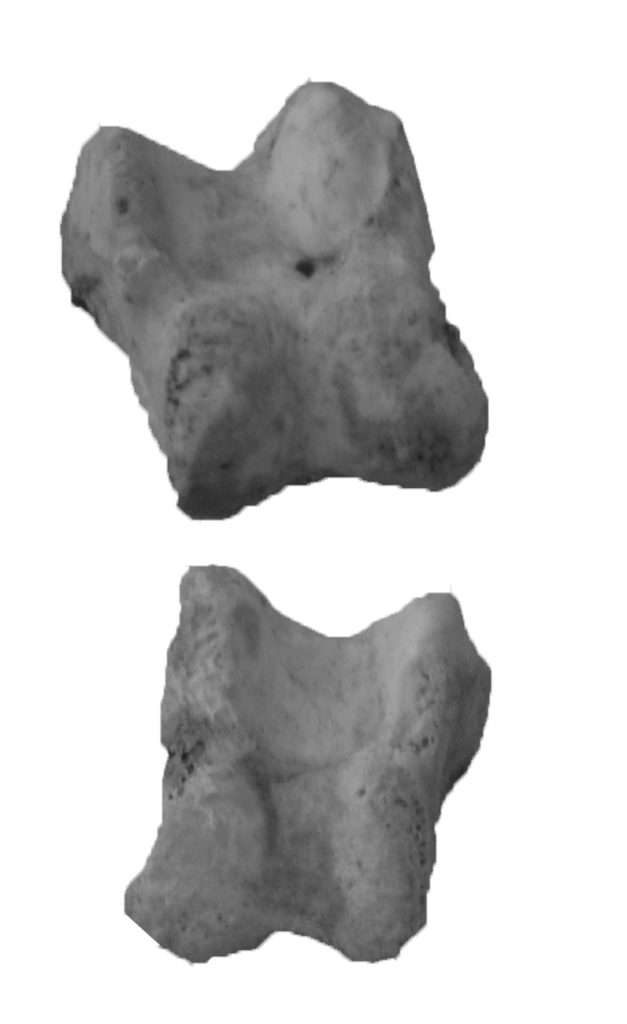
Knucklebones
Bone (sheep or goat)
Throughout history, people have used the bones of the animals they ate for different purposes. Knucklebones (sometimes the ankle bones of sheep or goats) were used across the ancient world to play different games. A huge variety of knucklebones have been found by archaeologists including pieces remade in gold, silver, marble and precious gems.
The simplest and very common form of the game ‘knucklebones’ was played by children, and is similar to the modern game of jackstones: all five pieces were tossed into the air, and the goal was to catch as many as possible on the back of one hand.
Reference: CANCM:nn
Can be found: The Garden Room Collection
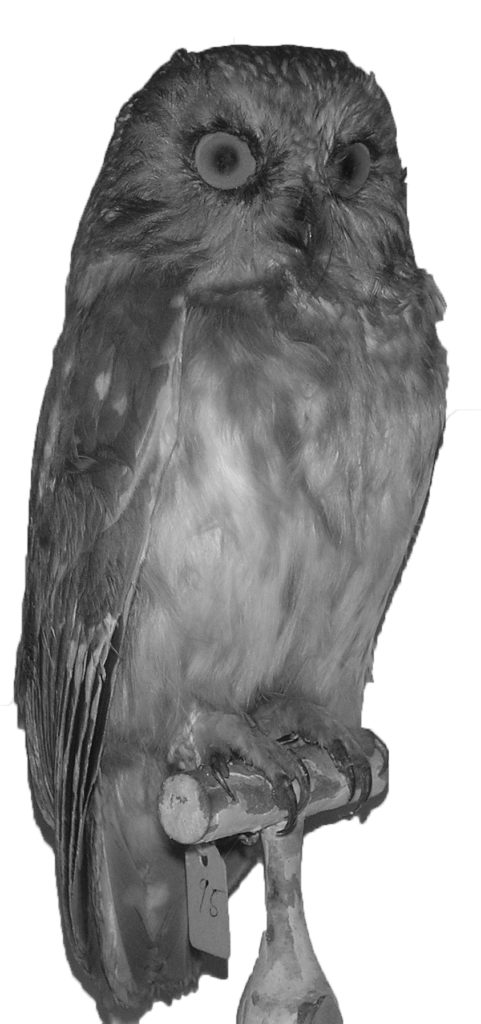
Little owl
Taxidermy (bird)
Little Owls eat beetles, worms, small mammals and birds and like lowland, farmland, parkland and orchards. They are common in the south east of England and were first introduced to Britain in the late nineteenth century.
The owl’s scientific name Athene noctua commemorates its association with Athena, the ancient Greek goddess of wisdom. We often think of owls as wise, partly because of this mythology. However, popular ideas about the intelligence of these birds may owe more to art and literature than to science.
Reference: CANCM:
Can be found: The Garden Room Collection

Mammoth Tusk
Found in Swalecliffe in 1935
Fossil (mammal)
Mammoths were close relatives of modern elephants. Their thick hairy coats enabled them to live in the harsh conditions that existed during the Ice Age. Scientists can work out a mammoth’s age at the time it died from the rings of its tusk. This tusk is around seventy thousand years old and was found on the beach in Swalecliffe.
Mammoths coexisted with humans until the animal became extinct around ten thousand years ago. Evidence shows humans hunted mammoths and used their bones and tusks to construct shelters. Like the aurochs, mammoths are also depicted in prehistoric European cave paintings.
Reference: 1986.4.61
Can be found: The Garden Room Collection
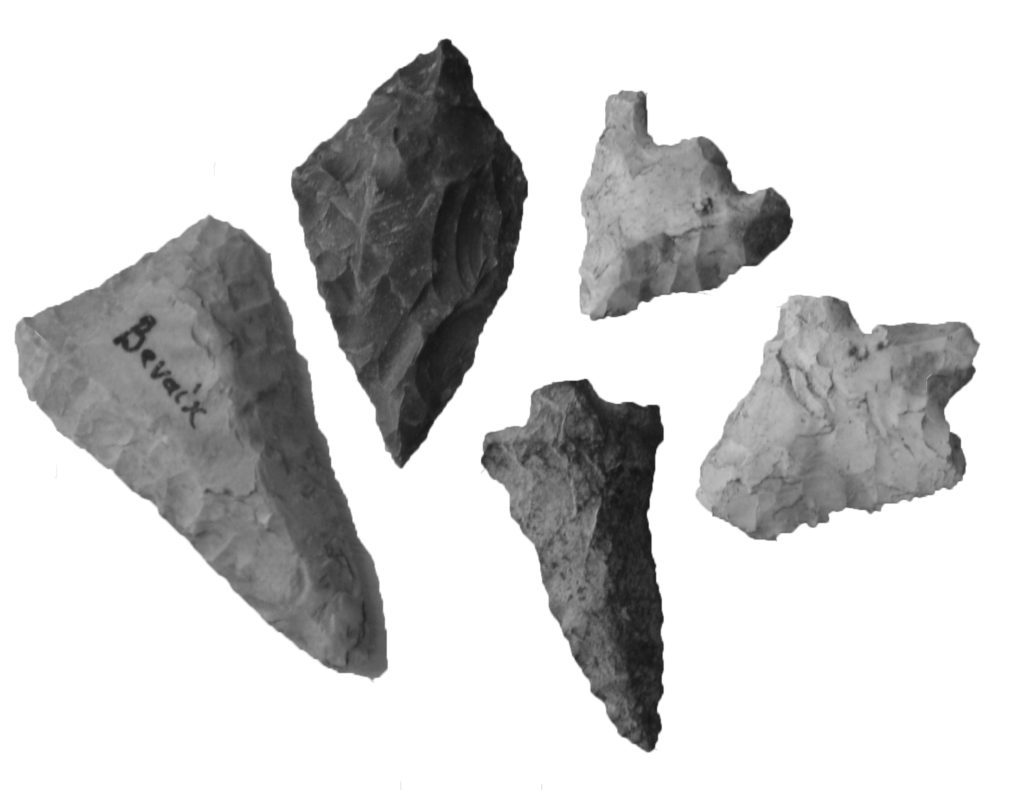
Neolithic arrowheads
Made in Bevais, 4500 BC – 2500 BC
Stone
These Neolithic arrowheads were made in Bevaix, a former municipality of Switzerland. Neolithic people would shape local materials such as flint into forms with very sharp points and edges through a process known as knapping.
These arrowheads would likely have been used for hunting wild animals for food. However the Neolithic period was a time of transition from nomadic hunter gathering towards small scale farming. Neolithic farmers began to domesticate animals such as cows, sheep and goats.
Reference: CANCM:755
Can be found: The Garden Room Collection
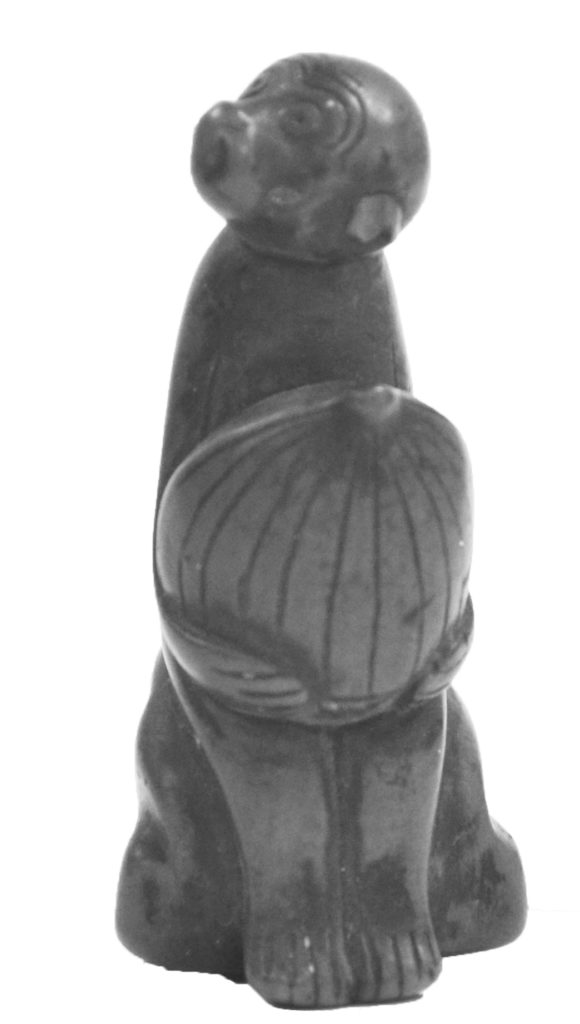
Netsuke (monkey holding a nut)
Made in Japan, about ?
Boxwood
At the time this object was likely made, Japanese men carried their possessions on silk cords. Netsuke like this would have a function as a kind of toggle, but they also held symbolic, spiritual and social value. This netsuke has quite a playful design: a monkey holding a nut. Monkeys feature quite prominently in the religion, folklore and art of Japan and are a popular theme in this kind of sculpture.
Although netsuke functioned as toggles, they were often made with a flat base so that they stand upright when displayed. Netsuke were designed to be enjoyable to touch and hold and are intended to be visually pleasing from all angles.
Reference: CANCM:1985.16.20
Can be found: The Garden Room Collection
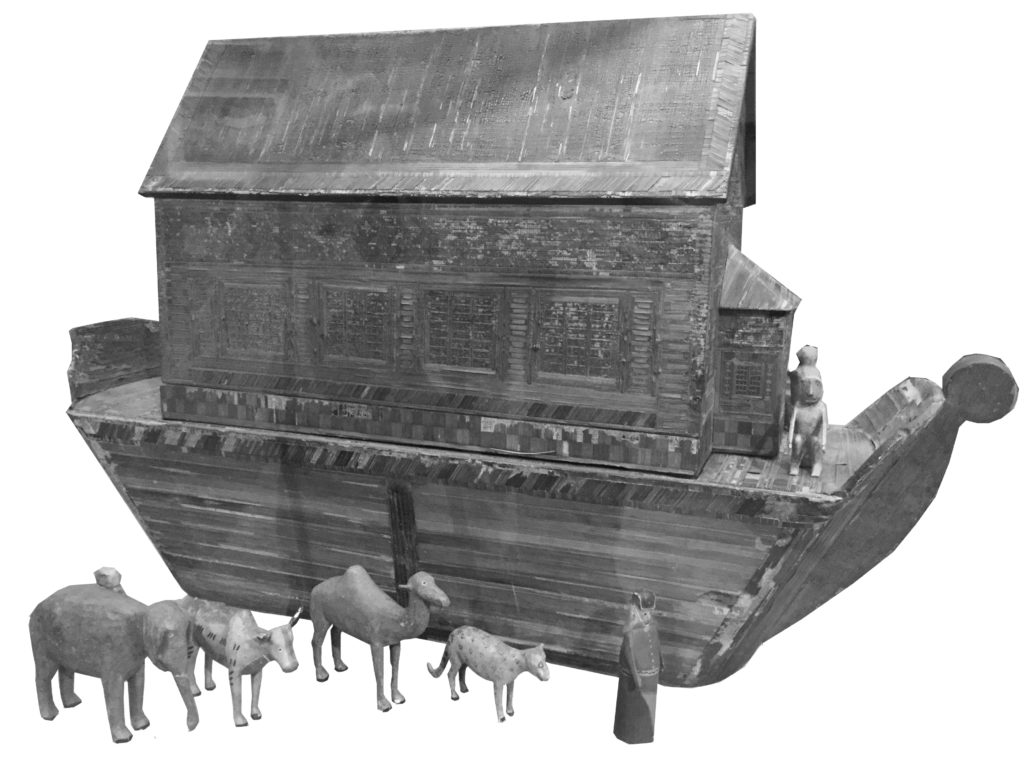
Noah’s ark toy set
Made in Germany, about 1840 Wood,
cut straw
Nineteenth century German toy makers were especially skilled in woodcarving thanks to long held traditions and the material provided by the country’s famous forests. All of the twenty eight animals in this toy set were hand carved and painted and the lid of the ark lifts off so they can all be stored inside.
Bible stories, such as Noah’s Ark, have helped shape perceptions of many animals. Noah’s dove, carrying the olive branch found after the flood, has endured as a symbol of peace after turbulent events. Artists and makers have used this symbolism for hundreds of years.
Reference: 1980.16.3
Can be found: The Garden Room Collection

Norman gaming counter
1100 - 1300 AD
Carved from cow’s jawbone
This gaming counter was carved from the jawbone of a cow. Many game pieces from the Norman period were made from bone like this one. It was found by Canterbury Archaeological Trust during the building of the extension to The Beaney in 2009/2010, along with other items such as tankards and clay pipes.
Board games like ‘tables’, backgammon, chess and draughts were popular amongst the nobility of medieval Europe. Such games were a source of fun in the Middle ages but were considered a particularly male pursuit as competition between two opponents was put in the context of strategy and sportsmanship.
On loan from the Canterbury Archaeology Trust
Reference: CANCM:nn
Can be found: The Garden Room Collection
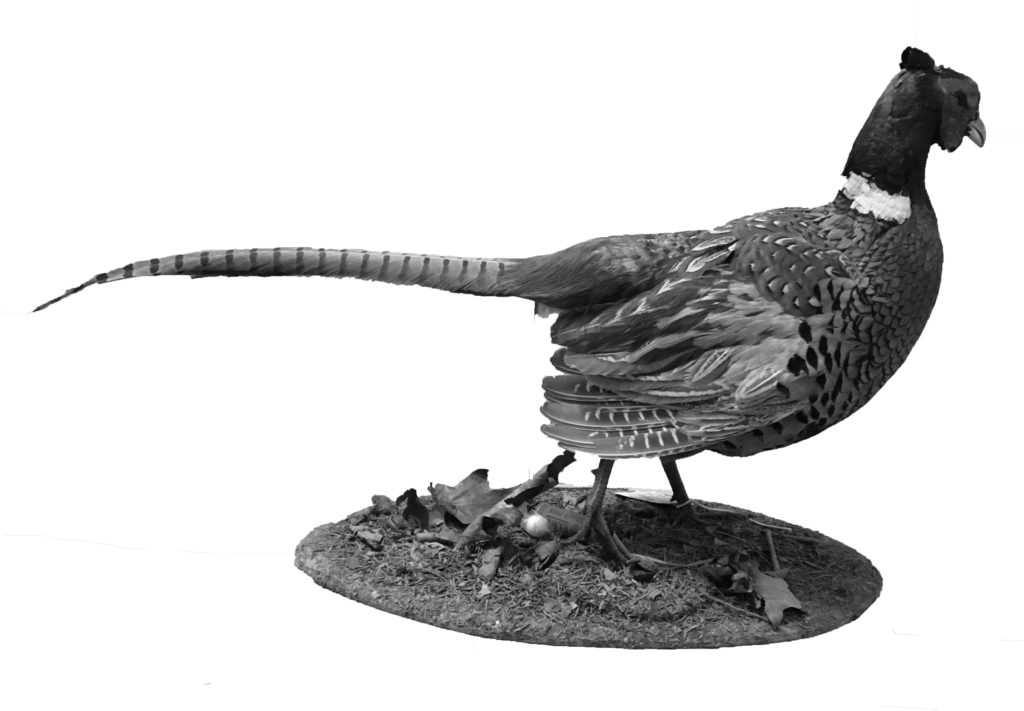
Pheasant
Taxidermy (bird)
Pheasants are large, long-tailed game birds that eat seeds, berries, leaves and insects. They belong to the same family as peacocks, and as is the case with peacocks, male pheasants usually have more colourful and elaborate plumage than the females. The bronze plumage, red face and green neck of this specimen show that it is a male.
Pheasants are native to Asia but were first introduced into Europe by the Romans. This specimen was mounted in the twentieth century along with the ammunition that shot the bird. In Britain today an estimated thirty five million pheasants are reared and released by gamekeepers for hunting each year which raises concerns for biodiversity in certain areas.
Reference: 2014.1
Can be found: The Garden Room Collection
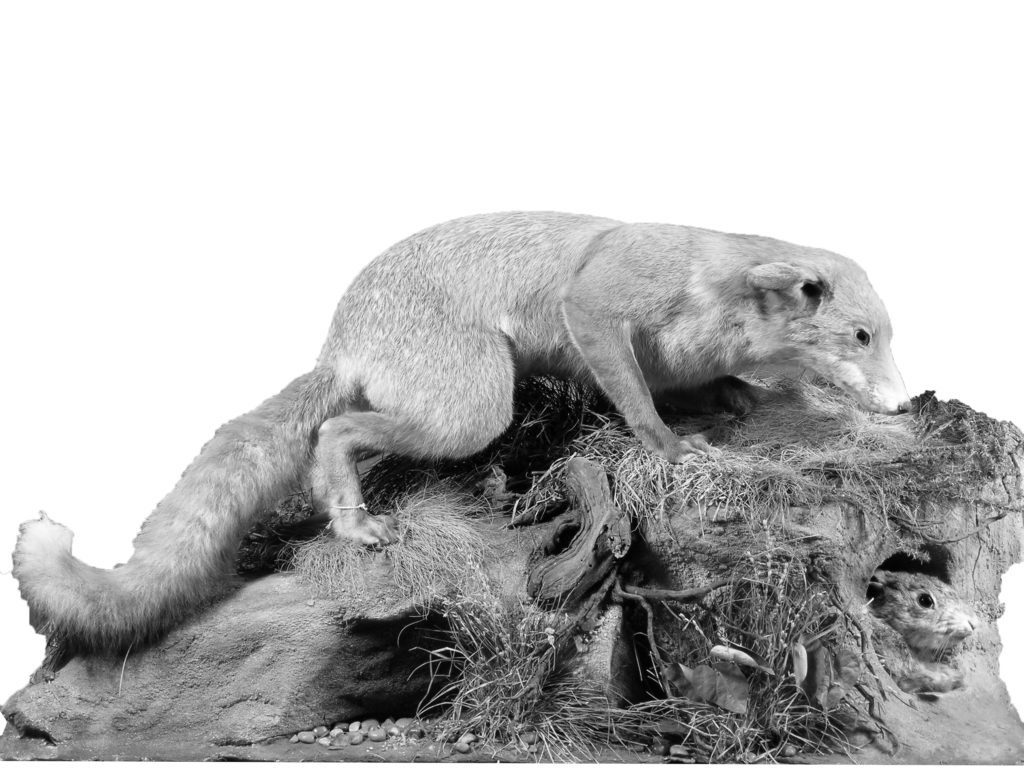
Red fox and rabbit
Taxidermy Diorama (mammals)
(This item has been temporarily removed from display for conservation work)
Foxes are one of few truly native British mammals. They live in burrows called dens or earths. They eat berries, fruit, worms, frogs, birds and small mammals like the rabbit in this diorama. However, our food waste has made urban areas appealing to foxes looking for easier meals and they are now a common sight in towns, streets and gardens throughout Britain.
In a literary tradition dating back to Aesop’s ancient Greek fables, story tellers including Geoffrey Chaucer and Mary Tourtel have portrayed foxes as cunning tricksters. Like many animals, the fox’s reputation has been shaped as much by art as it has by nature.
Reference: 1999.245
Can be found: The Garden Room Collection
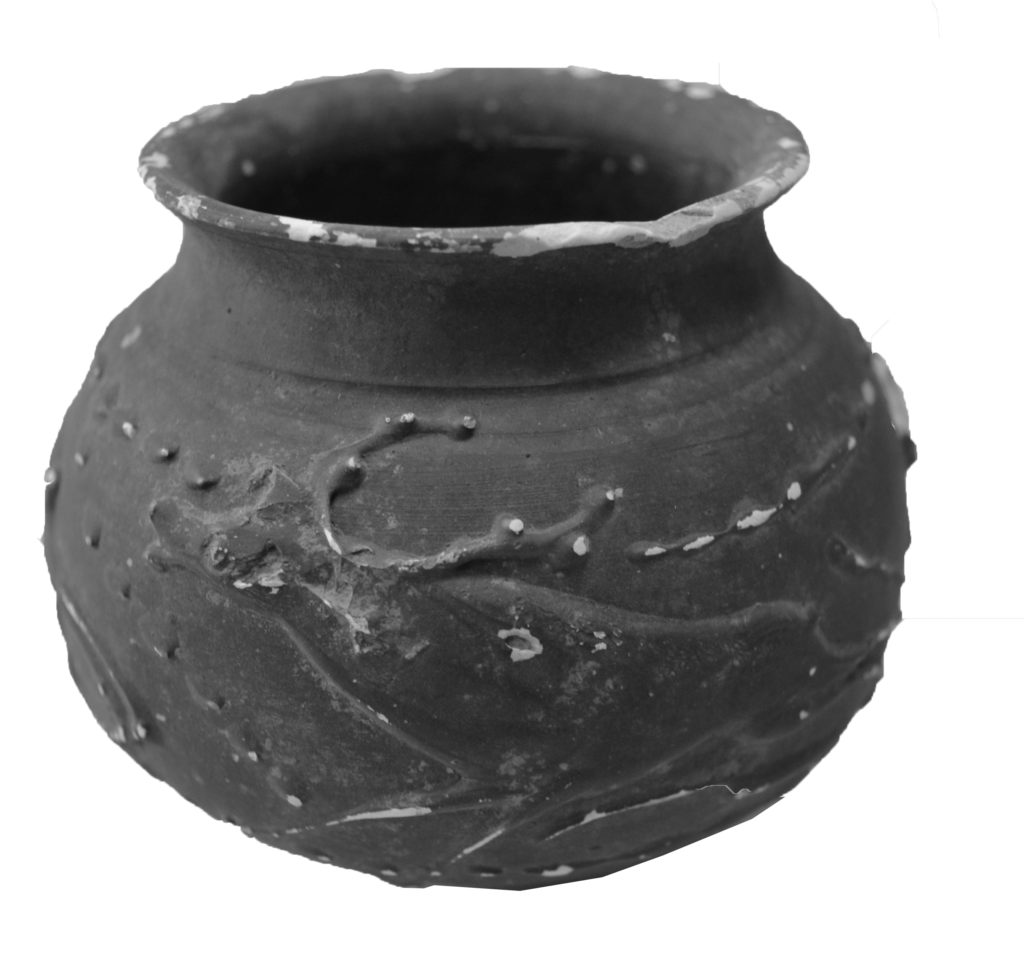
Roman hunt cup
Made in Britain, about 200 to 300 AD
Castorware
This hunt cup depicting two dogs chasing a deer would have been a very expensive and fashionable Roman drinking cup. The cup was discovered at St Martin’s Hill in Canterbury and is a type of Roman ceramic known as Nene Valley Pottery.
Archaeological evidence suggests there were quite a lot of dogs in Roman Britain. As this cup demonstrates, dogs were commonly used in hunting at the time. The deer depicted may well be a Fallow deer, a breed that the Romans first introduced to Britain and that became temporarily extinct here following the collapse of the Roman Empire.
Reference: 7488
Can be found: The Garden Room Collection

Rook in a redcoat
Taxidermy (bird)
Children playing in the early twentieth century captured and put a red coat on this rook. When it flew back to the rookery it’s flock rejected it and made such a noise that the keeper came and shot the bird.
The sad story of this rook might tell us something about the behaviour of these intelligent birds. Was it curious as to what the children were doing? How else did they get close enough to catch it? It also highlights two regrettable traits of our historical relationship with wildlife: using animals as a source of entertainment and persecuting those that inconvenience us.
Reference: 179 H
Can be found: The Garden Room Collection

Rupert Bear Royal Doulton ceramic Made around 1998
Ceramic
Animals have inspired an endless amount of childrens’ literature. Britain has produced a number of well known animal characters including three very famous bears; Winnie the Pooh, Paddington
and Rupert Bear. The museum’s collection of Rupert Bear figurines were kindly donated by the makers: Royal Doulton.
Rupert Bear is special to Canterbury as he was created here over one hundred years ago by Mary Tourtel. To find out more about the connection between Mary Tourtel and Thomas Sidney Cooper, just look for the display drawers in The Garden Room.
Reference: CANCM:2005.371.10
Can be found: The Garden Room Collection
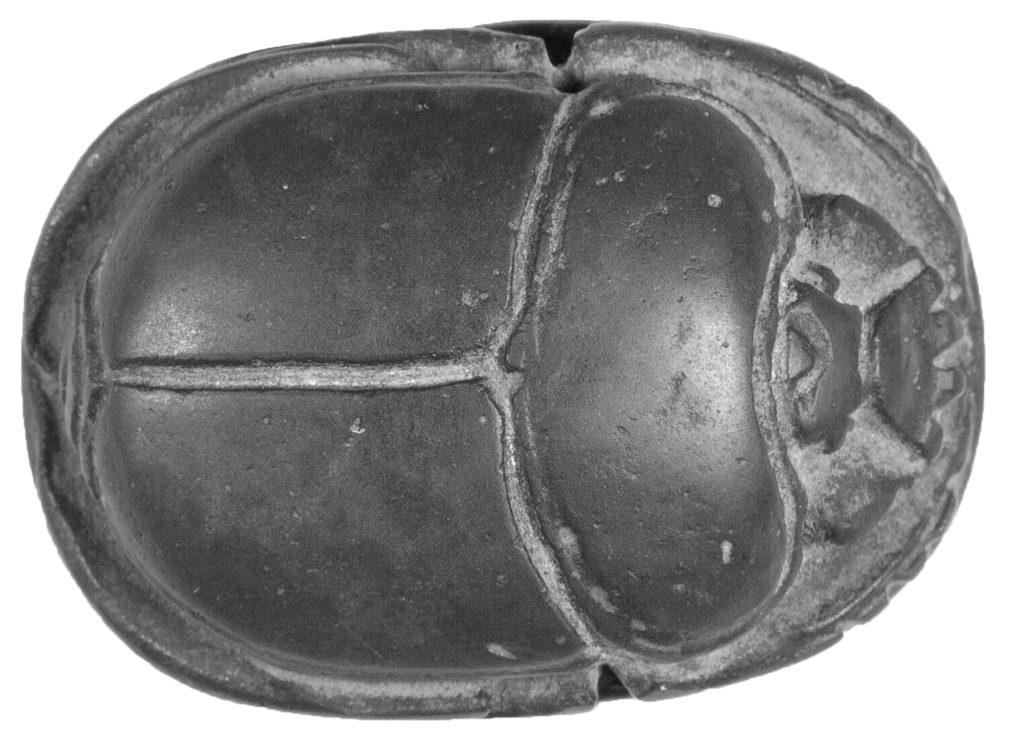
Scarab amulet
Made ancient Egypt around
Faience
Thousands of years ago scarab beetles were observed forming balls from animal dung in which they would lay their eggs. The beetles rolled these balls across the landscape which the ancient Egyptians likened to how the sun rose and set in the sky each day. The scarab beetle became sacred to the ancient Egyptians due to this perceived association with the sun and came to symbolise rebirth and renewal. You can see more amulets like this in the Ancient Egypt case in the Explorers & Collectors gallery upstairs.
Reference: E171
Can be found: The Garden Room Collection

Sculpture of a cow
Etruscan
Bronze on marble plinth
It is thought that cows were domesticated around 10,500 years ago. This bronze sculpture is more than 2500 years old and was made by the Etruscan people who lived in what is now Italy. This item is another example of how cows have inspired the art of many different cultures.
This sculpture’s marble base was added in the nineteenth century, showing that it was still much admired, thousands of years after its making. Like the paintings of Thomas Sidney Cooper, it reminds us of our long relationship with these particular animals.
Reference: 1996.70.2
Can be found: The Garden Room Collection

Sculpture of a gerbil or mouse Egypt
Bronze
This bronze sculpture of a gerbil or mouse eating is very similar to a great variety of small sculptures from the Roman period. It came from Egypt and could have been made during Roman rule in the country which began with the arrival of Octavian (later called Augustus) in 30 BC.
Small bronzes of mice clasping food in their paws have been found in Roman sites throughout Europe in numbers that suggest they must have been very popular. It seems likely that these sculptures didn’t have a purpose other than to be decorative, amusing and charming.
Reference: 5899
Can be found: The Garden Room Collection
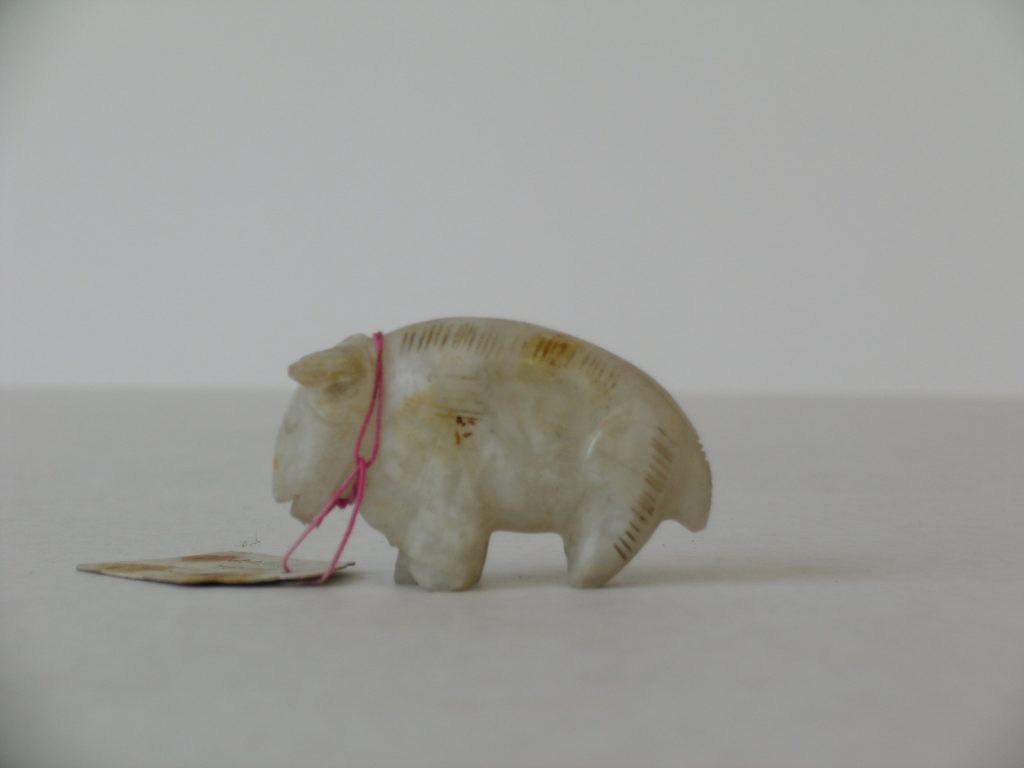
Standing bull ornament
Collected in Khotan, China, 1888
Jade
This item carved from jade is one of a pair collected by the Reverend Henry Lansdell on his travels around Asia, the other is on display in the Explorers & Collectors gallery upstairs at The Beaney.
This bull dates from the same time that Thomas Sidney Cooper was painting the bulls you can see on display in The Garden Room. Historically, the success of many human communities depended heavily on cattle and consequently these animals have featured extensively in art, mythology and religion throughout the world.
Reference: 2006.56.30
Can be found: The Garden Room Collection
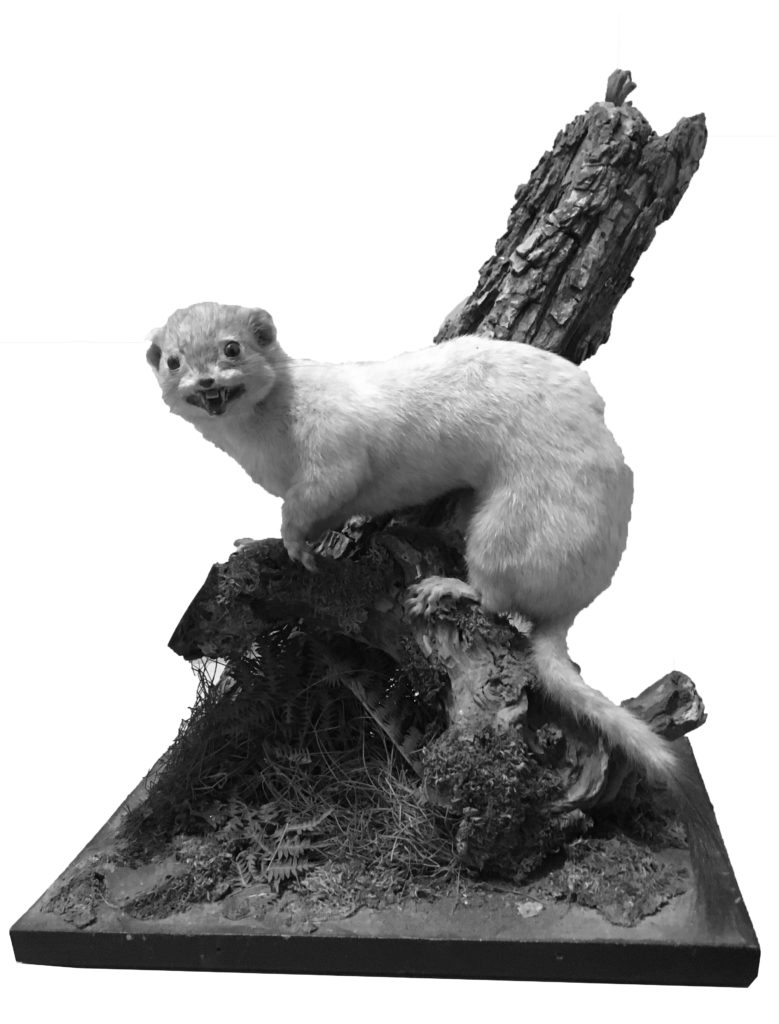
Stoats
Taxidermy (mammal)
(This item has been temporarily removed from display for conservation work)
A stoat is a small predator, closely related to otters and weasels. They hunt and eat rodents and rabbits, sometimes bigger than themselves! Stoats can be found across Britain in woodlands, heaths and grasslands.
The reddish brown example here is a stoat with its summer coat whereas the white specimen has its winter coat. The white acts as a good camouflage in snow. The stoat’s winter coat, known in the fur trade as ermine, was historically used to make royal robes in Europe and appears in many royal portrait paintings.
Reference: 1990.69 / CANCM:1999.226.1-2
Can be found: The Garden Room Collection

Stone Carving (armorial design) Made around fifteenth century
Stone
Armorial designs are made up of symbols that represent a person, family, organisation, or country. The three lions were the coat of arms of Canterbury before Edward III came to the throne in 1327. This carving was rescued from the south wall of St George’s Church in Canterbury when it was demolished.
Heraldic symbolism shows us how animals have influenced ideas and identities for a long time. People have often associated different species with certain qualities such as the perceived courage of the lion. For centuries animals have been deployed as symbols, in order to identify a family or nation, with the qualities represented by a particular species.
Reference: CANCM:6852
Can be found: The Garden Room Collection

Stone carving of a dog chasing its tail
Made in England around 1080
Stone
This carving is one of several excavated in Church Lane in Canterbury. It dates from around the same time as the famous Bayeux Tapestry, the embroidery that tells the story of the Norman conquest of England in 1066. Among other animals, the Bayeux tapestry includes over thirty dogs in its design, some of which appear to chase their own tails like the dog in this stone carving.
There would have been quite a lot of dogs in medieval Canterbury, most would have been used in hunting, or for herding and guarding cattle like those depicted centuries later in Cooper’s paintings.
Reference: 1983.10.1051
Can be found: The Garden Room Collection
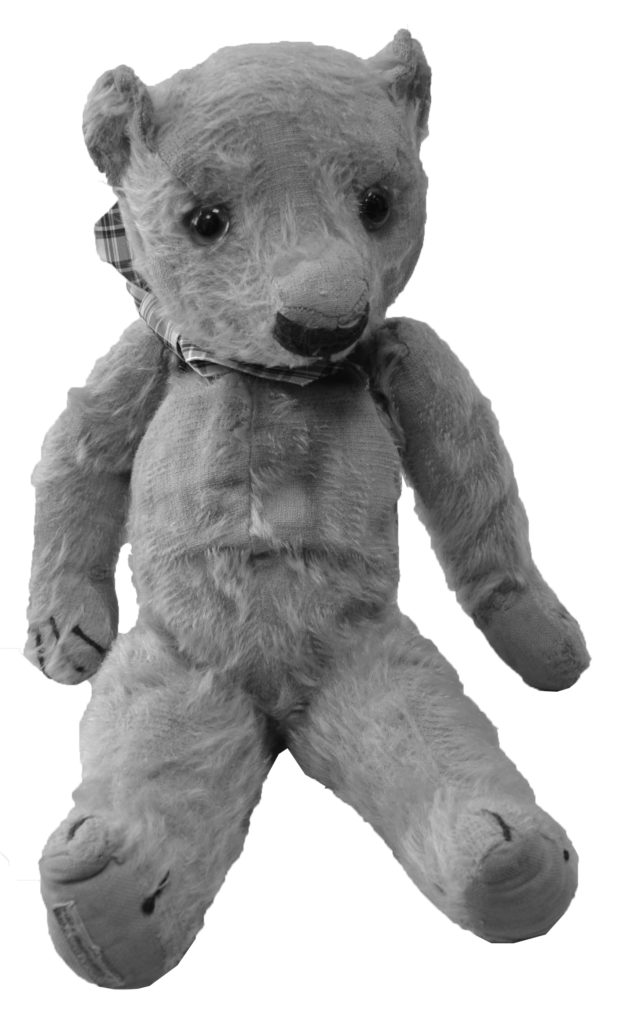
Teddy bear
Made around 1940
Plush fabric
(This item has been temporarily removed from display for conservation work)
This toy bear belonged to Jennifer Baker and was her companion when she was evacuated from Canterbury as a child during World War Two. Toys like ‘Teddy’ would have been hugely important in comforting children whose lives were upturned by the blitz.
We think of Teddy Bears as a quintessential childhood toy, however their history is relatively short. Although toy bears can be found further back in history, we owe their modern popularity and their name to former American President Theodore Roosevelt. Around 1903 the president supposedly refused to kill a bear on a hunting trip, a popular political cartoon depicting the event then captured public imagination and created a market for ‘Teddy Bears’.
Reference: 2013.8.1
Can be found: The Garden Room Collection
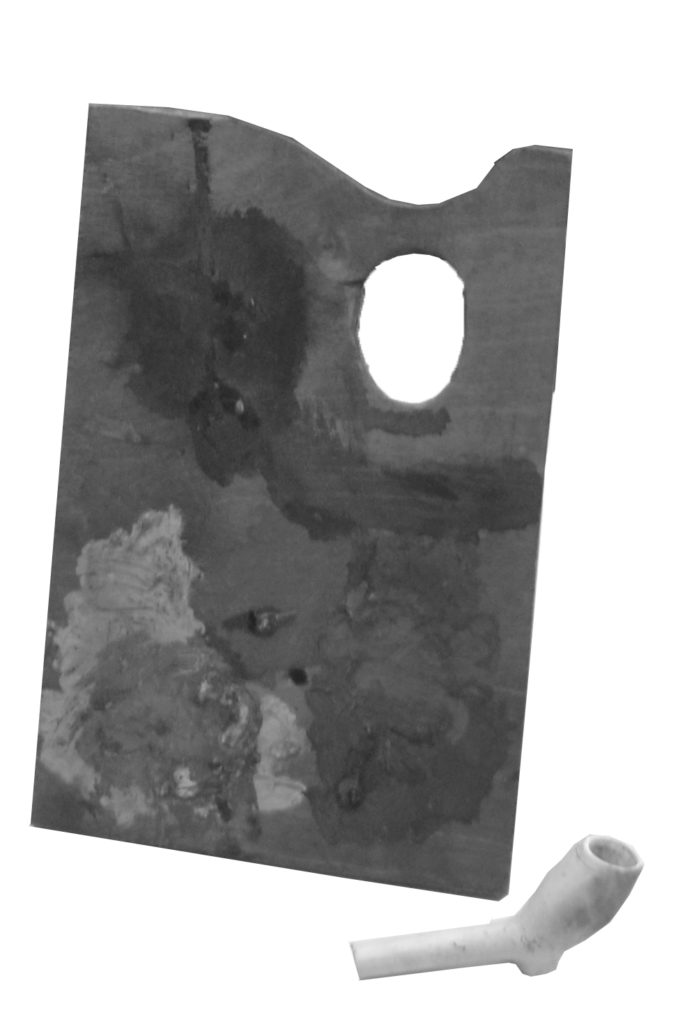
Thomas Sidney Cooper’s artist palette and a clay pipe
Nineteenth century
This is one of the palettes on which Thomas Sidney Cooper mixed the paint he used to create works like those on display in The Garden Room. When painting, Thomas Sidney Cooper also sometimes smoked a pipe made from clay like the one on display.
You can find Cooper’s palette and his pipe in paintings on display in The Garden Room. He is pictured with his palette in a self portrait whereas the pipe is an often overlooked detail in one of the largest paintings on display in the gallery.
Reference: CANCM:nn
Can be found: The Garden Room Collection
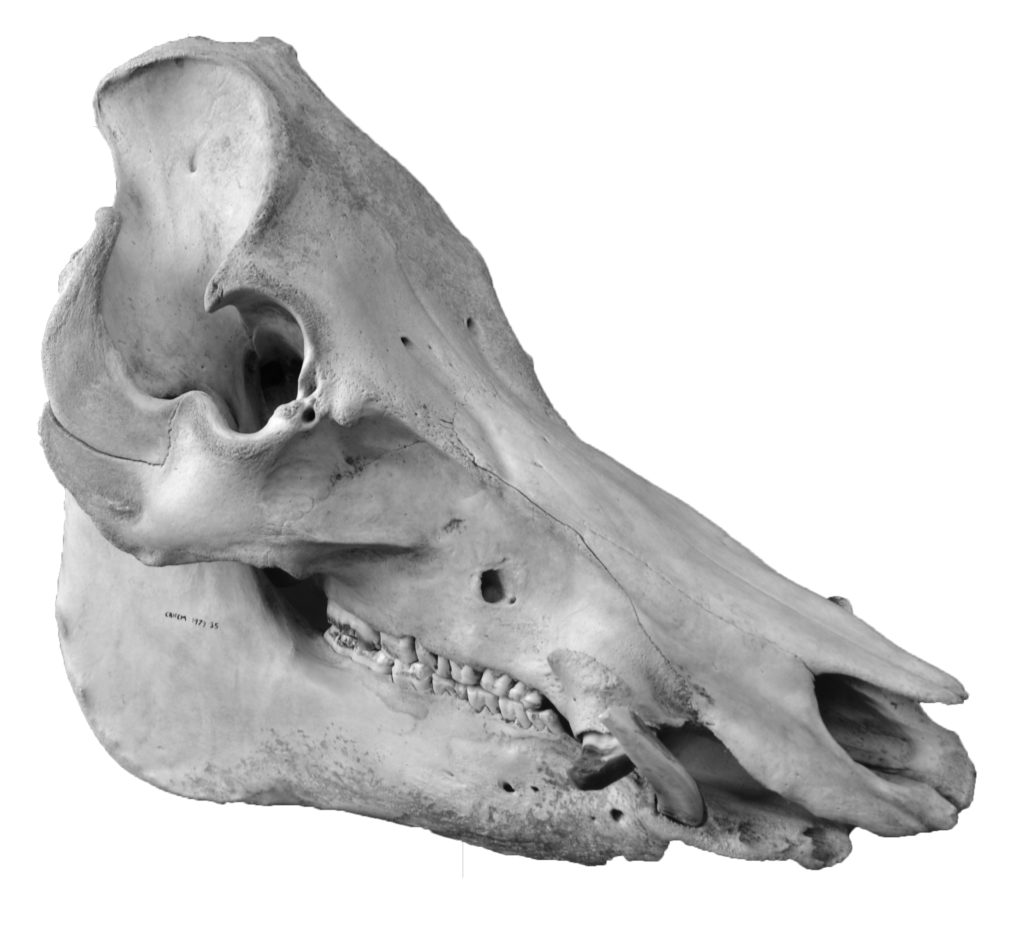
Wild boar skull and jawbone
Skeleton (mammal)
The majority of a wild boar’s diet is made up of roots, bulbs, seeds, nuts and green plants. However they will eat much of what they find including small mammals, eggs, worms and insects. During the breeding season, male boar use their tusks as weapons in confrontations with rivals.
Wild boar are a species that were once native to Britain but were hunted to extinction during the Middle Ages. The boar living wild in the country today are thought to be descended from animals that escaped or were released from farms. This specimen is from Shepway in Kent.
Reference: CANCM:1979.35
Can be found: The Garden Room Collection

